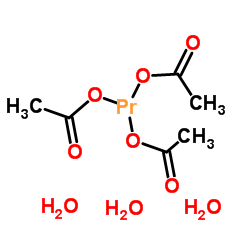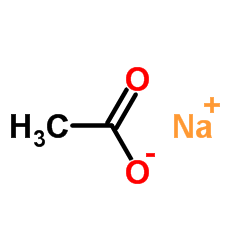6192-12-7
| 中文名 | 乙酸镨(III)水合物 |
|---|---|
| 英文名 | praseodymium acetate |
| 中文别名 |
乙酸镨(III)
醋酸镨 |
| 英文别名 |
Tris(acetato-κO)praseodymium trihydrate
Praseodymium, tris(acetato-κO)-, hydrate (1:3) PRASEODYMIUM ACETATE EINECS 228-242-4 Praseodymium(III) acetate hydrate MFCD00150121 |
| 密度 | 1.2g/cm3 |
|---|---|
| 沸点 | 536.2ºC at 760 mmHg |
| 分子式 | C6H15O9Pr |
| 分子量 | 372.086 |
| 闪点 | 278.1ºC |
| 精确质量 | 371.979218 |
| PSA | 78.90000 |
| 外观性状 | 绿色固体 |
| 折射率 | 1.618 |
| 储存条件 | 避光,阴凉干燥处,密封保存 |
| 稳定性 | 常温常压下稳定,绿色水晶颗粒。 溶于水,难溶于乙醇,不溶于吡啶。加热至270℃以上分解。加热至790℃时,生成氧化镨(Ⅲ,Ⅳ)。(Pr6O11)。 与DMF作用,得到Pr(CH3COO)3·DMF,熔点151~155℃,真空加热至210℃,可脱去DMF。与1,10菲咯啉作用[157],得到绿色结晶,加热至270~300℃分解。与硫脲作用,得到熔点为197~198℃绿色结晶,溶于水。与2,2′-联吡啶作用,得到的络合物为绿色晶体,加热至250~260℃分解。 |
| 分子结构 | 1、摩尔折射率:无可用的 2、摩尔体积(cm3/mol):无可用的 3、等张比容(90.2K):无可用的 4、表面张力(dyne/cm):无可用的 5、介电常数:无可用的 6、极化率(10-24cm3):无可用的 7、单一同位素质量:317.947513Da 8、标称质量:318Da 9、平均质量:318.0397Da |
| 计算化学 | 1、 氢键供体数量:0 2、 氢键受体数量:6 3、 可旋转化学键数量:0 4、 拓扑分子极性表面积(TPSA):120 5、 重原子数量:13 6、 表面电荷:0 7、 复杂度:25.5 8、 同位素原子数量:0 9、 确定原子立构中心数量: 0 10、 不确定原子立构中心数量:0 11、 确定化学键立构中心数量:0 12、 不确定化学键立构中心数量:0 13、 共价键单元数量:4 |
| 更多 | 1. 性状:绿色固体,具吸湿性。 2. 密度(g/mL,25℃):未确定 3. 相对蒸汽密度(g/mL,空气=1):未确定 4. 熔点(ºC):151~155 5. 沸点(ºC,常压):未确定 6. 沸点(ºC,23mmHg):未确定 7. 折射率:未确定 8. 闪点(ºF):未确定 9. 比旋光度(º):未确定 10. 自燃点或引燃温度(ºC):未确定 11. 蒸气压(20ºC):未确定 12. 饱和蒸气压(kPa,60ºC):未确定 13. 燃烧热(KJ/mol):未确定 14. 临界温度(ºC):未确定 15. 临界压力(KPa):未确定 16. 油水(辛醇/水)分配系数的对数值:未确定 17. 爆炸上限(%,V/V):未确定 18. 爆炸下限(%,V/V):未确定 19. 溶解性:未确定 |
|
Section 1: Product Identification Chemical Name:Praseodymium (III) acetate hydrate (99.9%-Pr) (REO) CAS Registry Number:6192-12-7 Formula:Pr(OOCCH3)3.XH2O EINECS Number:none Chemical Family:metal acetate salt Synonym:Acetic acid, praseodymium(+3) salt, hydrate
Section 2: Composition and Information on Ingredients IngredientCAS NumberPercentACGIH (TWA)OSHA (PEL) Title Compound6192-12-7100%no datano data Section 3: Hazards Identification Emergency Overview:Irritating to skin, eyes and respiratory tract. Primary Routes of Exposure:Ingestion Eye Contact:Causes slight to mild irritation of the eyes. Skin Contact:Causes slight to mild irritation of the skin. Inhalation:Irritating to the nose, mucous membranes and respiratory tract. Ingestion:No information on the physiological effects of ingestion. Acute Health Affects:Irritating to skin, eyes and respiratory tract. Chronic Health Affects:No information available on long-term chronic effects. NTP:No IARC:No OSHA:No SECTION 4: First Aid Measures Immediately flush the eyes with copious amounts of water for at least 10-15 minutes. A victim may need Eye Exposure: assistance in keeping their eye lids open. Get immediate medical attention. Wash the affected area with water. Remove contaminated clothes if necessary. Seek medical assistance if Skin Exposure: irritation persists. Remove the victim to fresh air. Closely monitor the victim for signs of respiratory problems, such as difficulty Inhalation: in breathing, coughing, wheezing, or pain. In such cases seek immediate medical assistance. Ingestion:Seek medical attention immediately. Keep the victim calm. Give the victim water (only if conscious). SECTION 5: Fire Fighting Measures Flash Point:not applicable Autoignition Temperature:none Explosion Limits:none Extinguishing Medium:carbon dioxide, dry powder or foam If involved in a fire, fire fighters should be equipped with a NIOSH approved positive pressure self-contained Special Fire Fighting Procedures: breathing apparatus and full protective clothing. Hazardous Combustion andIf involved in a fire this material may emit toxic organic fumes. Decomposion Products: Unusual Fire or Explosion Hazards: No unusual fire or explosion hazards. SECTION 6: Accidental Release Measures Spill and Leak Procedures:Small spills can be mixed with vermiculite or sodium carbonate and swept up. SECTION 7: Handling and Storage Store in a tightly sealed container in a dry place. If container is left open, salt may adsorb moisture from the Handling and Storage: atmosphere. SECTION 8: Exposure Controls and Personal Protection Eye Protection:Always wear approved safety glasses when handling a chemical substance in the laboratory. Skin Protection:Wear appropriate chemical resistant gloves and protective clothing. Ventilation:Material may form a fine dust. If possible, handle the material in an efficient fume hood. If in form of fine dust and ventilation is not available a respirator should be worn. The use of respirators Respirator: requires a Respirator Protection Program to be in compliance with 29 CFR 1910.134. Ventilation:Material may form a fine dust. If possible, handle the material in an efficient fume hood. Additional Protection:No additional protection required. SECTION 9: Physical and Chemical Properties Color and Form:green xtl. Molecular Weight:318.04 Melting Point:no data Boiling Point:no data Vapor Pressure:not applicable Specific Gravity:no data Odor:none Solubility in Water:very soluble SECTION 10: Stability and Reactivity Stability:hygroscopic solid Hazardous Polymerization:no hazardous polymerization Conditions to Avoid:contact with moisture Incompatibility:Oxidizing agents and active metals Decomposition Products:Carbon dioxide, carbon monoxide, organic vapors, and metal oxides and carbonates. SECTION 11: Toxicological Information RTECS Data:No information available in the RTECS files. Carcinogenic Effects:No data available Mutagenic Effects:No data available Tetratogenic Effects:No data available SECTION 12: Ecological Information Ecological Information:No information available SECTION 13: Disposal Considerations Disposal:Dispose of according to local, state and federal regulations. SECTION 14: Transportation Shipping Name (CFR):Non-hazardous Hazard Class (CFR):NA Additional Hazard Class (CFR):NA Packaging Group (CFR):NA UN ID Number (CFR):NA Shipping Name (IATA):Non-hazardous Hazard Class (IATA):NA Additional Hazard Class (IATA):NA Packaging Group (IATA):NA UN ID Number (IATA):NA SECTION 15: Regulatory Information TSCA:Listed in the TSCA inventory. SARA (Title 313):Title compound not listed. Second Ingredient:none SECTION 16 - ADDITIONAL INFORMATION N/A |
|
毒理学数据: 主要的刺激性影响: 在皮肤上面:刺激皮肤和粘膜 在眼睛上面:刺激的影响 致敏作用:没有已知的敏化现象
|
| 危害码 (欧洲) | Xi |
|---|---|
| 风险声明 (欧洲) | R36/37/38 |
| 安全声明 (欧洲) | S26-S36-S37-S39 |
|
~% 
6192-12-7 |
| 文献:Egypt. J. Chem., , vol. 26, p. 125 - 132 Sc: MVol.D4, 1.4.10, page 52 - 53 |



